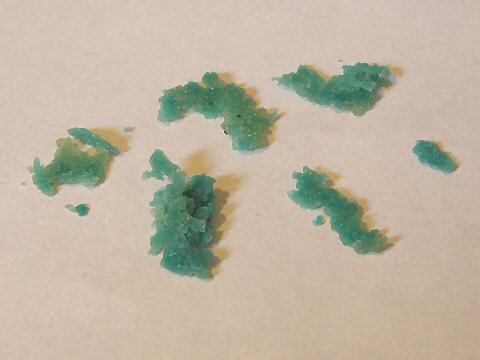The collection of A.C. Gilbert toys at A.C. Gilbert’s Discovery Village features a few items that would shock the modern parent, like a chemistry set that contained the poison sodium cyanide and an atomic energy kit that included a small sample of radioactive material. “He also had a glass blowing kit for boys,” says Vorachek, pointing out the extreme temperatures necessary to turn molten sand into glass. “You wouldn’t be able to do that now.” In addition to radioactive material, the atomic energy kit included a Geiger counter and an offer to earn $10,000. “The U.S. Government was willing to pay people up to $10,000 to take that Geiger counter and go prospecting for uranium,” says Vorachek. “Toys have really changed!”
– A.C. Gilbert and The Power of Play

I have not, however, previously run into bright blue crystals in my wine. And a good teaspoonful or more of them. I won’t name names (at the moment), but it was a 2006 Torrontés from Salta.
I have heard of blue casse, a bluish haze which develops in a wine that happens to have a high iron content (generally naturally occurring from having been grown in iron rich soil, say, Salta here in Argentina for example), to which an unusually large amount of tannic acid has been added – a process I’m not entirely clear on. I can only assume that the addition of tannic acid is to make the wine seem like it’s “more important” by giving a cheaper wine a perceptible level of tannins… but that’s generally a hazy cloud in the wine, not a crystal precipitate.
There’s a process called blue fining, the addition of potassium ferrocyanide to the wine to help clear it of various impurities, which does settle out as a blue crystal precipitate – I haven’t seen it before, but I assume it looks something like this. The idea with fining, however, is to filter out the precipitate before bottling – and actually, blue fining is illegal in many countries (not sure about here in Argentina) because if some of the crystals remain in the bottle they can create hydrogen cyanide gas in the wine (that famous spy poison, you know?), though there’s never been a recorded case of a high enough level in a bottle of such wine to be considered toxic – still, it’s not a good thing, you know?
So, wine microbiology or chemistry folk, what say you about this bit of crystalline blueness?
In trawling the net for a bit of info on this, and then leading to the decline of the chemistry set, I came across this Wired video that makes for an interesting watch…
I’d guess the crystals are a precipitate of a copper sulfate solution. The solution, in varying strengths, is used to control fungal blight on grapes and other produce.
Yep, always wash your produce.
Dan,
Thouugh not an expert by any means, I have never seen the crystals you have found in an Argentine wine.
If they were some kind of precipitate of potassium ferrocyanide (in the form of ferric ferrocianide, which I believe is its subproduct), I understand that -according to INV’s (Instituto Nacional de Vitivinicultura) regulations (specifically Resolution INV N° 106/92), it should not be present in any form in the wine. Perhaps you should consider bringing this to the attention of the INV officials since I understand they take these matters very seriously.
BTW, the admitted levels of chemicals in Argentina can be found here, at the INV’s website (http://www.inv.gov.ar/normativas.php?ind=2).
Best regards,
Ignacio
You can find an online form to submit the INV a complaint regarding consumer issues at http://www.inv.gov.ar/defensa_cons.php
Best regards,
Ignacio
My first thought too was copper, just based on the blue-green color, but a little online and book research shows that copper precipitates from wine in a rust-red color. Blue-green is derfinitely noted as an iron-based precipitate, either from the combination of iron ions with tannic acids or from the iron compound of cyanide. If the latter, indeed I wouldn’t be happy about that showing up in the wine (especially as the wines are made by friends of mine, and I have fired off an e-mail to them to find out what their response is), if the former, it’s also not a good thing, though not dangerous, just simply would mean they’re doctoring the wine with additional tannin.
So how was the wine?
It was okay, but not great. It seemed very heavy, almost a touch viscous, for a Torrontés – even before noting the crystals I’d thought that it somehow seemed… doctored, or as if perhaps it wasn’t pure Torrontés and some much weightier grape had been blended in.